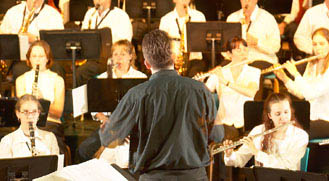Dr. James Cain, noted diagnostician at Mayo Clinic, impressed upon me the importance of coming to the clinic over a long period of time so that they could develop a health pattern for me—that is, so that they could set up ranges on the elements of my health. As long as I stayed within those parameters, they were not concerned, even though there were some idiosyncrasies. If I veered from the baseline, they immediately began to find out why. I have found that with discernment we are able to determine patterns of behavior in our associates, particularly those who are close and important to our leadership. Christ had three inner circle disciples, and I find most leaders need to have a few close to them to share in the leadership. A healthy organization has a healthy oligarchy. I have found it helpful to employ people in the area of their gifts and passions. Then you have only to coordinate them, not supervise them. They will come nearer to overdoing than under-doing. Their motivation comes from within. I have established a long list of items by which to discern the skills and passions of my people. It would be too lengthy for this discussion; but it would begin with character, for I have found that character determines how a person uses his or her intelligence. Next I want to know the person's confidence level, which permits him or her to attempt something with a positive attitude and with concentration. The power of confidence is that it permits the full use of concentration. Loss of concentration is often disastrous. Oftentimes you will hear sports commentators say that a team has lost its confidence when in actuality it has lost its concentration. Concept of self is important—how does the person see himself?—not his self-image, but his self-worth. This has a lot to do with a person's willingness to accept responsibility and to develop himself. People who are clear on their self-worth see life as a challenge; those who are foggy see it as a threat. People skills are important, particularly in team play. It is important to see how they relate to others. Loners can be stars but rarely good team members. It is good to know if a person is collaborative or competitive, and under which conditions and circumstances. A person's skill and passion should promote the vision of the organization. In non-profit organizations the volunteers are the larger group, so it is doubly important to establish patterns for the core leaders. The paid staff must be role models. You won't get volunteers to work any harder than the employees. Getting the right people in the right place with the right attitude is more important in a small organization than a large one. Arithmetically, one person in a group of a hundred represents only 1 percent, while one person in a small group of five represents 20 percent. Unfortunately I've seen some small organizations that lacked the confidence to demand quality in each individual. The smaller the organization, the more quality each individual must have. Jim Collins in his best seller, Good To Great, speaks of the critical effort to make sure that the right people are "on the bus, in the right seats" and that the wrong people are off the bus. This becomes essential in a smaller organization. We employed a temp in our office. In a few weeks one of the Vice Presidents wanted to let her go because he deemed her a "smart aleck." My question to him was, "Is she a smart aleck or is she smart?" I asked her to be transferred to me and found her both bright and aggressive. In a few months he was gone and she was taking on additional responsibility. Leadership means understanding people, identifying a system for measuring and finding the right fit. Recognizing patterns of behavior enables us to create a state of higher productivity.
Understanding People
The art of discerning patterns in others.
By Fred Smith

